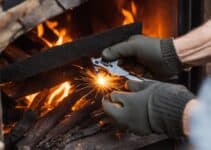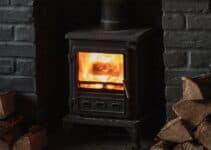When addressing the pivotal question of what size flue pipe for wood stove is appropriate, clarity is key. My experience in installing and maintaining wood stoves impels me to emphasise that selecting the wood stove flue pipe size is not merely a detail—it’s a determinant of your stove’s performance and safety.
The best size flue pipe for wood stove efficiency correlates directly with the internal diameter of your stove’s flue collar. Therefore, if your wood stove brandishes a 6” flue collar, it necessitates a 6” stove and chimney pipe to assure a seamless, safe ascent of the smoke through the roof.
Conformity is the watchword—matching the proper flue pipe size for wood stove specifications promises a synergy that enhances the draft and amplifies the efficacy of your stove. Respecting these dimensions, I can guide you through a variety of promising brands and types like the Snap-Lock for your installation, taking into account factors such as heat reclamation and draft optimisation all while staying within the bounds of your unique requirements.
Understanding the Importance of Proper Flue Pipe Size for Your Wood Stove
When I embark on the task of choosing the right size flue pipe for my wood stove, the importance of compatibility and precision comes to the forefront. To ensure that my readers can make informed decisions, let’s delve into the relationship between the flue pipe size and the efficiency of a wood stove, as well as the repercussions of choosing a size that does not align with manufacturer recommendations.
Correlation Between Flue Pipe Size and Stove Efficiency
It’s well acknowledged that the efficiency of a wood stove is inherently linked to the size of its flue pipe. A correctly sized pipe facilitates an unimpeded passage for smoke and fumes, leading to an improved draft. Enhanced draft not only boosts efficiency but also contributes to a more complete combustion process, minimising creosote buildup and ensuring the wood stove performs at its peak. As I regularly remind my clients, adhering to wood stove pipe size recommendations is not merely a suggestion—it’s quintessential for the stove’s optimal functionality.
Impact of Incorrect Flue Sizing on Wood Stove Performance
Selecting a flue pipe that does not match the diameter specified by the stove’s design can lead to a myriad of complications affecting performance. If the flue pipe is too small, it can restrict the flow of emissions, resulting in poor draft and inefficiency. Conversely, an oversized flue could lead to excessive cooling of the combustion gases, which reduces draft and can cause smoke spillage into the room. In advising on wood stove chimney pipe size, I emphasise the delicacy of this balance to prevent underperformance and related hazards.
Below, I have constructed a table delineating the typical wood stove pipe diameters and their corresponding stove output, enabling homeowners to understand the guidelines in selecting the appropriate flue pipe size:
| Stove Output (kW) | Recommended Flue Pipe Diameter (inches) |
|---|---|
| Up to 5 kW | 5″ |
| 5 to 8 kW | 6″ |
| 8 to 10 kW | 7″ |
| 10 kW and above | 8″ or more |
It’s important to note that these recommendations can vary depending on the specific needs and considerations of a wood stove’s design. Consulting the manufacturer’s guidelines or seeking advice from a professional is crucial for ensuring safe and efficient operations.
Measuring Your Wood Stove for the Correct Flue Pipe Diameter
Understanding the precise wood stove flue pipe diameter is crucial for optimal performance and safety. It’s imperative that I measure the flue collar’s inside diameter to ascertain the correct flue pipe size for the wood stove. This action cannot be overstated in its importance, as it ensures a harmonious and efficient connection between the wood stove, the flue pipe, and the chimney system.
Firstly, I ensure the stove is cool and safely accessible. Then, using a reliable tape measure or caliper, I carefully measure the interior diameter of the stove’s flue collar. It’s essential to be as exact as possible, as even small discrepancies can lead to significant performance issues or safety hazards. The process of how to measure flue pipe size requires precision and an understanding that the flue pipe and chimney pipe must align in diameter to maintain the requisite airflow and draft for efficient combustion.
Below is a simple guide to aid in selecting the correct diameter for a wood stove’s flue pipe based on the measurement taken:
| Flue Collar Diameter | Recommended Flue Pipe Size |
|---|---|
| 5 inches (127mm) | 5-inch (127mm) Flue Pipe |
| 6 inches (152mm) | 6-inch (152mm) Flue Pipe |
| 7 inches (178mm) | 7-inch (178mm) Flue Pipe |
| 8 inches (203mm) | 8-inch (203mm) Flue Pipe |
If you are replacing an existing flue pipe, it’s also a good practice to check the part of the chimney where it will connect to ensure that the same diameter is used throughout. Always remember, inconsistencies between the flue pipe diameter and the chimney opening can cause inefficient burning, increased creosote buildup, and even the risk of a chimney fire.
Beyond the diameter, factors such as the length of the flue pipe and the type of wood stove installation will play a role in selecting the appropriate pipe. Consulting with a professional or referring to the stove manufacturer’s recommendations can often provide additional guidance tailored to your specific situation.
Upon confirming the correct wood stove flue pipe diameter, you can proceed to select the flue pipe that will deliver the best performance for your wood stove setup, maintaining peace of mind that it is safe, effective, and up to the necessary standards.
Choosing Between Different Flue Pipe Materials and Brands
When it comes to installing a wood stove, selecting the right flue pipe is not just a matter of connecting one end to the stove and the other to the chimney. The choices made here impact the stove’s functionality, resilience, and safety. One must weigh up the merits of different flue pipe materials, gauge their longevity, and consider reputable brands that offer reliable solutions. As I delve into the intricacies of flue pipe selections, I will lay out the nuances of single-wall versus double-wall options, scrutinise the durability of materials used, and provide insights into leading flue pipe brands to guide your decision-making process.
Comparing Single-Wall vs Double-Wall Flue Pipes
The use of single-wall black stove pipe is widespread owing to its cost-effectiveness and ease of installation. These pipes fit the bill for rooms with ample clearance from combustibles, and they grant the advantage of connecting with heat reclaimers to enhance the stove’s efficiency. Conversely, the double-wall pipe durability is a notch higher, presenting an improved safeguard against the heat transfer to combustible materials and boosting the overall draft efficiency of the stove system.
Determining the Durability and Longevity of Flue Pipe Materials
It’s apparent that material quality is pivotal for the resilience of flue pipes. Steel encapsulated in a double-layer with an air gap or insulation fosters a double-wall pipe’s longevity, resisting corrosion and thermal wear over time. On the other hand, though sturdier than their stainless-steel counterparts, single-wall flue pipes undergo faster deterioration when subjected to intense heat repeatedly, without the insulating benefits that double-wall construction provides.
Insights on Leading Brands for Wood Stove Flue Pipes
In the realm of flue pipe brand comparison, expertise and trust come to the fore. Market leaders, known for their innovation and quality, offer various options that cater to different needs. Brands like Selkirk manufacture robust double-wall flue pipes that assert both safety and longevity, while Duravent stands tall with products acclaimed for seamlessly matching durability with performance. Considering economic viability, single-wall black stove pipe offerings from Snap-Lock serve as a cost-effective choice without drastically compromising quality.
| Brand | Type | Material | Usage Scenario | Expected Longevity |
|---|---|---|---|---|
| Selkirk | Double-wall | Stainless steel with insulation | Reduced clearance from combustibles | Long-term |
| Duravent | Double-wall | Galvanised exterior, stainless interior | Enhanced draft efficiency | Moderate to long-term |
| Snap-Lock | Single-wall | Black steel | Budget-friendly options, larger clearances | Short-term to moderate |
When to Use an Increaser: Connecting Disparate Flue and Chimney Sizes
As a seasoned installer, I am often faced with the challenge of ensuring a seamless flue to chimney size connection when the diameters of the wood stove flue collar and chimney pipe do not match. In scenarios where an existing chimney has a larger diameter than the wood stove’s flue collar, a wood stove increaser becomes essential. This is particularly true for installations that involve transitioning, say, from a 6” flue to an 8” chimney.
Utilising a flue pipe increaser at the onset of the flue run – as close to the chimney as practicable – is critical for maintaining a consistent and safe exhaust flow, minimising the risks associated with back-drafting and underperformance of the heating system.
The introduction of a wood stove increaser allows for a proper fit between dissimilar-sized pipes, but it’s important to proceed with caution; alterations to the flue system can unintentionally lead to complications such as reduced draft efficiency and possible backflow of smoke into the living space.
| Flue Collar Diameter | Chimney Diameter | Recommended Increaser | Potential Impact |
|---|---|---|---|
| 6 inches | 8 inches | 6” to 8” Increaser | Optimises chimney draw; risk of back-smoking if poorly installed |
| 5 inches | 6 inches | 5” to 6” Increaser | Improves connection; possible heat loss due to size transition |
| 4 inches | 6 inches | 4” to 6” Increaser | May affect stove efficiency; proper draft crucial to prevent issues |
It’s essential to acknowledge that installing a wood stove increaser should be managed by professionals to avoid any inadvertent compromise to the stove’s performance. The objective is to produce a safe, efficient, and long-lasting flue to chimney size connection that matches the unique requirements of each wood stove setup.
The Role of Flue Liners in Enhancing Wood Stove Safety and Efficiency
As an avid proponent of resourceful stove use, I’m keenly aware of the flue liner necessity in residential wood stove installations. While many overlook this component, let’s delve into why it’s instrumental in optimising your stove’s performance and safety.
Do You Need a Flue Liner for Your Wood Stove?
Quite simply, yes. A flue liner serves as an essential safety measure, preventing heat transfer that could potentially ignite surrounding combustible materials. It also vastly improves your wood stove’s ability to draw air, ensuring more effective combustion and thus, a cleaner burn.
Benefits of Flue Liners in Wood Stove Installations
- Containment of Combustible Emissions: By confining the by-products of combustion, a flue liner mitigates the risks of creosote buildup—a potential fire hazard.
- Protection of Masonry: It acts as a protective layer, safeguarding your chimney from the corrosive effects of soot and tar.
- Improved Efficiency: Liners are designed to maintain optimal flue temperatures for a more efficient burn, reducing wood consumption and saving on fuel costs.
Understanding Different Grades of Flue Liners
Flue liners come in varying grades, each intended for specific heating requirements:
| Flue Liner Grade | Fuel Compatibility | Usage Recommendation |
|---|---|---|
| 316 Grade | Seasoned Wood | For average home use with proper wood treatment |
| 904 Grade | High-Temperature Fuels | Ideal for heavy-duty operations and high-efficiency stoves |
Whether you’re utilising seasoned timber or high-temperature fuel alternatives, selecting the appropriate flue liner grade will ensure your installation is tailored effectively to your stove’s operational parameters.
What Size Flue Pipe for Wood Stove: Ensuring Compliance with Building Regulations
As I delve into the intricacies of selecting the correct flue pipe size for your wood stove, it’s imperative to also understand the legalities surrounding this process. Ensuring compliance with UK Building Regulations not only guarantees the safe operation of your heating appliance but is also a legal requirement. Consequently, flue installation becomes a multi-faceted task that necessitates thorough attention to Building Regulations, flue safety certifications, and the specifics of chimney design flue size.
Navigating UK Building Regulations for Flue Installation
Adhering to UK Building Regulations is a critical step in the flue installation process. These regulations are designed to promote the safety and efficiency of flue systems nationwide. It’s my responsibility to ensure that any flue installation I oversee is compliant with these standards, often referencing documents like Approved Document J, which lays out specific requirements for combustion appliances.
Importance of Certifications and Standards for Safety
To further bolster safety and compliance, flue components should boast the appropriate certifications. The quality and suitability of the material used are paramount, and flue safety certifications such as the BS EN1856-2 are endorsements of a flue’s ability to operate effectively under the harshest conditions. It’s these certifications that I look for when selecting flue liners or pipes, offering peace of mind that they meet stringent safety benchmarks.
How Chimney Location and Design Affects Flue Sizing
When it comes to chimney design flue size, it’s not a one-size-fits-all situation. The specific location and architectural design of a chimney can influence the optimal sizing for a flue pipe. The height of the chimney, its distance from the peak of the roof, and its potential proximity to nearby obstructions can all impact flue size consideration. It’s my aim to maintain efficient functioning and prevent draft issues by meticulously considering these factors during the design phase of a flue system.
Conclusion
In the quest for safe wood stove installation, I can’t overemphasise the importance of selecting the optimal flue pipe size for performance. Throughout this piece, it has been established that the efficiency of wood burning is highly contingent on the harmony between the stove’s flue collar and the chosen flue pipe diameter. A discrepancy in these two key aspects could result in suboptimal functioning or, worse yet, present safety hazards within the home.
Educating oneself on the role of flue liners furthers our commitment to maintaining safe and efficient wood fuelled fires. These liners not only bolster the integrity of our heating systems but also contribute to the longevity and sustainability of our equipment. Adherence to safety standards shouldn’t just be a consideration; it constitutes the cornerstone of successful wood stove operation. I advocate for a meticulous approach to ensure that the installation abides by relevant building regulations and certifications.
Solidifying what I’ve conveyed, the unified message penultimately revolves around achieving a cohesive wood stove system that ensures optimal performance and safety. My journey in exploring the dynamics of proper flue pipe sizing is testament to its imperative role in the realm of efficient wood burning. By integrating these critical elements, wood stove users can rejoice in the warmth and comfort of their hearths, with an assured peace of mind regarding their system’s safety and eco-friendly combustion.



